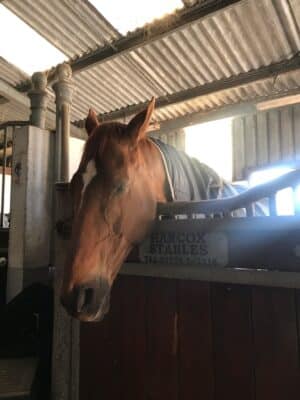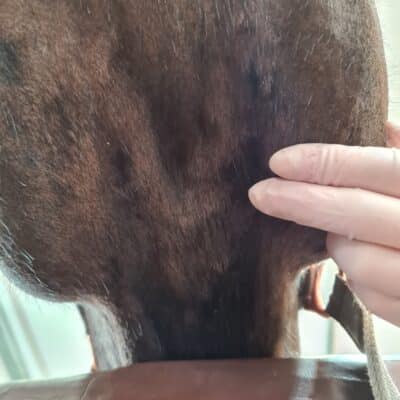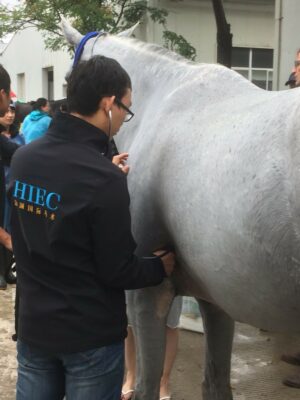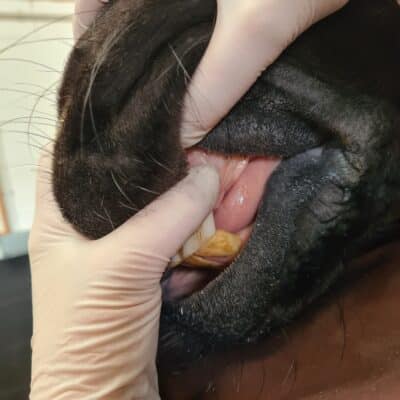Featured, First Aid, Veterinary
What is the normal temperature for a horse? Assessing the vital signs
Rebecca Watson MSc RVN, explains why knowing what the normal temperature for a horse should be, can help you see when something’s wrong
Assessing your horse’s vital signs means more than just knowing the normal temperature for a horse or, knowing what their normal heart and respiratory rates should be. Each time you enter your horse’s stable you should take note of his demeanour; how your horse behaves can tell you a lot about how he is feeling – always be vigilant.

Stable vices, if your horse has any, should be counted as part of his normal behaviour e.g. crib biting / wind sucking / weaving / box walking.
Subtle behavioural changes can indicate whether or not there might be something you need to worry about. Get to know what is normal for your horse but, do remember that every horse is different, they are all individuals.
How does your horse behave in the stable?
Is he bright and alert? Interested in his surroundings? Does he look up at you as you approach the door? Or is he standing at the back of the stable with his head lowered and not paying attention to his surroundings?
Does he lie down at lot? Or even at all? Horses are prey animals and need to feel relaxed and secure in order to lie down to rest.
If you have to travel for a show, normal behaviour may be slightly altered given the horse is away from home, for example, some horses will not lie down in a strange stable or environment, others will continue to do so regardless.
Respiration or breathing
Before you enter the stable is a good time to count his respiratory rate – before you distract and disturb him. Look at the way he is breathing, the rate and the depth of each breath, is there anything irregular about it? Or does he appear relaxed and normal? Do his nostrils flare when he takes a breath? The normal respiration rate for an adult horse is 8-16 breaths per minute, foals are higher and will vary with age.
Limb soundness
How comfortable is your horse moving around the stable? Does he move around easily? Or are his steps short or shuffling? Does he rest any of his limbs? Or one limb in particular?
It is normal for the horse to move and redistribute the weight in all four feet regularly, this is important for healthy circulation of blood in the hooves. But, if he is ‘saving’ his front feet, by redistributing his weight to the hind limbs or, shifting his weight more obviously with more effort and, more frequently then this could be a sign of laminitis.
How do his limbs look? Are they sleek and free from any swellings? How do they feel? Are they cool to touch?
In a resting horse, standing in his stable, all four limbs should be cool to touch (unless the environmental temperature is very warm) any heat could be indicative of an underlying injury. The hooves should also be cool to touch. If there is heat in any of them, check the ‘digital pulses’.
A strong, ‘bounding’ or throbbing digital pulse is an indication of inflammation in that foot, pulses will feel unusually strong because it is harder for the blood to pass into the blood vessels below. It does not mean the pulse rate is increased, but strength of the pulsations are stronger. It could be early warning signs of laminitis or, it could be a stone bruise.
Get used to what a normal digital pulse feels like, so you will be able to recognise an abnormal one more easily. The digital arteries run down the fetlock, at either side of the sesamoid bones and on down the back of the pastern. The easiest part to feel them is towards the outside and towards the inside of the back of the fetlock (over the sesamoid bones) it can be tricky in horses with hairier limbs. Press firmly enough to be able to feel the pulse, but not too firmly that you occlude the blood supply!
The gastrointestinal tract
Take note of how many piles of droppings are in the stable; are the droppings hard and formed or are they soft? Is the bed tidy or disturbed? Some horses routinely make a mess of their bed – if this is normal behaviour for that individual, it should give no cause for concern. But if your horse is usually settled and has a relatively tidy bed – alarm bells should go off if you arrive to find his bed pawed up into mountains of straw or shavings. Check the hay and feed pots; is your horse eating normally?
Absence of any piles of droppings should always give cause for concern. The normal horse will defaecate some ten to twelve times a day – some more! Again, get used to what is normal for your horse. Take care if the droppings change in consistency, drier droppings may indicate poor hydration and predispose him to impaction colic.
If you have as stethoscope you can listen for gut sounds or borborygmi. Listen to all four quadrants of the abdomen; the upper and lower left and right sides. Normal gastrointestinal motility will be represented by rumbling and gurgling sounds in all four quadrants, high pitched pings are normal and indicate the presence of gas. The absence of sounds in any or all of the quadrants is cause for concern.
Is the bed wet? Check the water bucket / drinker – has he been drinking normally? Obviously, this is harder to monitor if the horse has access to an automatic drinker, if you are concerned about inadequate water intake – switch to offering water in a bucket which allows for accurate monitoring.
The circulatory system
If you have a stethoscope you can auscultate or listen to your horse’s heart to determine the heartrate. You should position the ‘bell’ of the stethoscope on the left side of the ribcage in behind the horse’s elbow.
Some horses can get excited by the sensation of having their heart listened to (they may associate it with having a veterinary examination before getting a needle for a vaccination). If this happens, give him a scratch on his withers, this will relax him (in the same way that horses mutually groom at the wither area) – you should be able to notice the heart rate slowing to normal.
Listen to the heart for a full minute before you start to count the beats – to give him a chance to relax. Count the number of beats in 15 seconds and multiply by four if your horse will not stand still for a full 60 seconds.
The normal heart should make a ‘LUB DUB’ sound, assessment should include the rate (average adult heart rate is 22-44 beats per minute, foals will vary depending on their age). Rhythm (note if the beats have an irregular rhythm – is it regularly irregular, or just irregular?) and sound (listen for murmurs, such as swishing or buzzing sounds).


If you don’t have a stethoscope to listen to the heart, you can check the pulse rate of your horse by feeling the artery on his face, just under the curvature of the cheek bone, on either side of the lower jaw.
Check the mucous membranes
The mucous membranes colour can be examined for colour (normal colour is salmon pink) and the capillary refill time checked.
Blanch the mucous membranes by applying pressure with one of your fingertips, the capillaries should refill with blood (colour) in 1-2 seconds.
It is easiest to assess the mucous membranes of the lips or gums but occasionally dark pigmentation can prevent this, in which case you can look at the conjunctiva or nostrils (or the vaginal membranes in fillies or mares). When assessing the gums, check excessive salivation or for signs of dryness or tackiness – which can be indicators of dehydration.
Temperature
Lastly, you can check your horse’s temperature if you have a thermometer. You may need to tie the horse up to achieve this or to enlist the help of a friend to do this safely. Always stand to one side of the horse – never directly behind him – as you take the rectal temperature. To get an accurate measurement ensure your thermometer is placed up against the side of the rectum and not in the middle of a ball of faeces. The normal temperature for a horse (adult) is 37.2-38.3⁰C (99-101⁰F) a foal is 37.5-38.9⁰C (100-101.5⁰F). Remember a horse with a fever may not necessarily feel warm to touch, touch the extremities – the ears / limbs and hooves – to check if they feel exceptionally cold.
Also read: What should I put on my horse’s wound?

